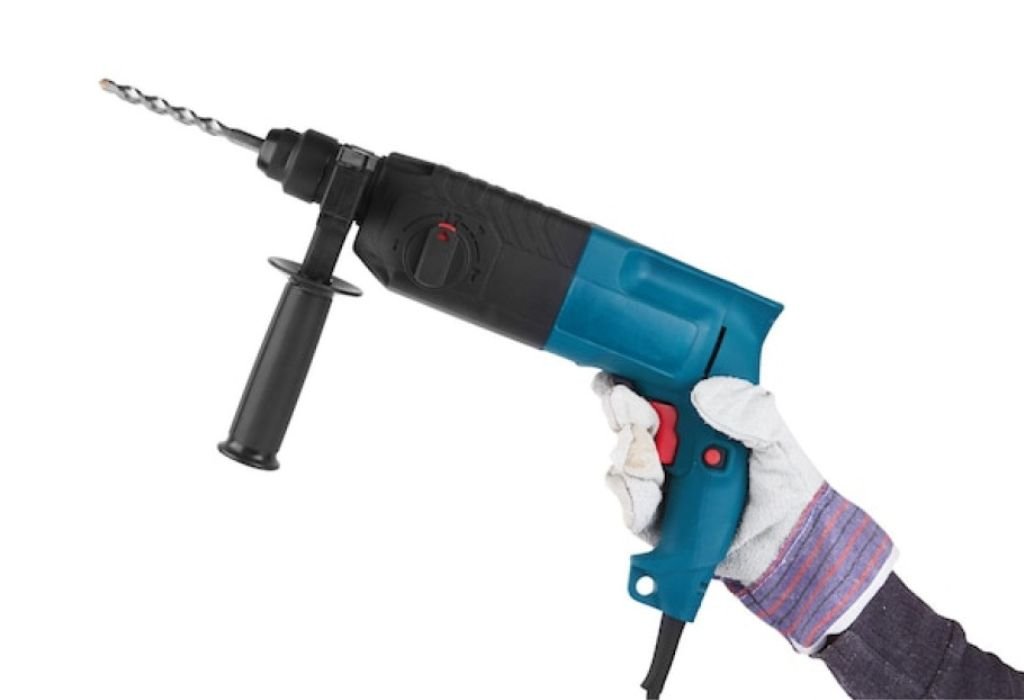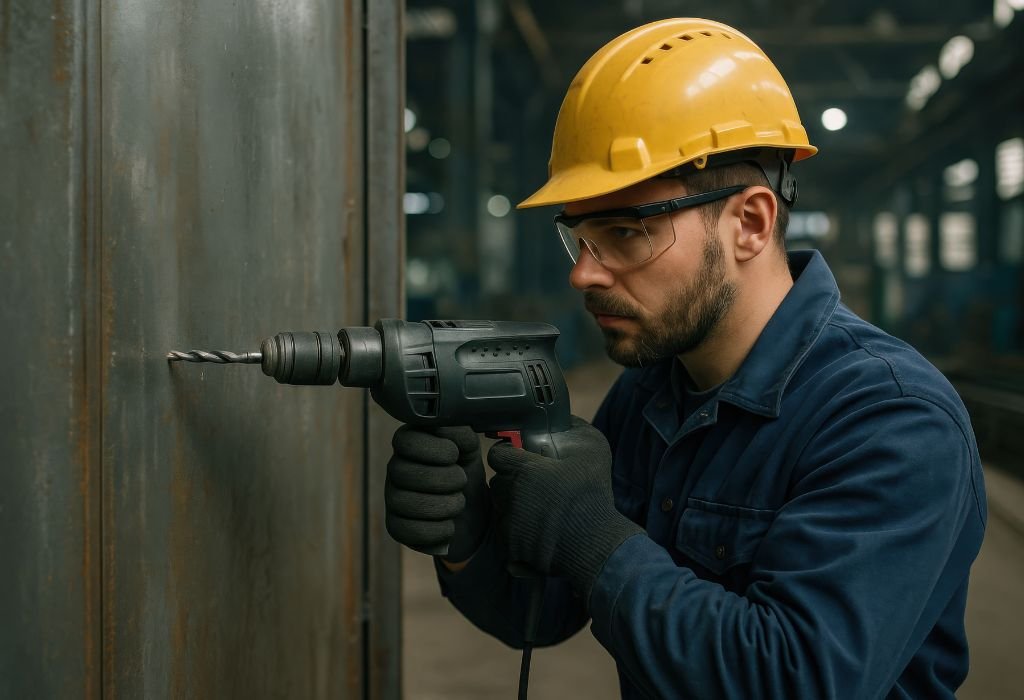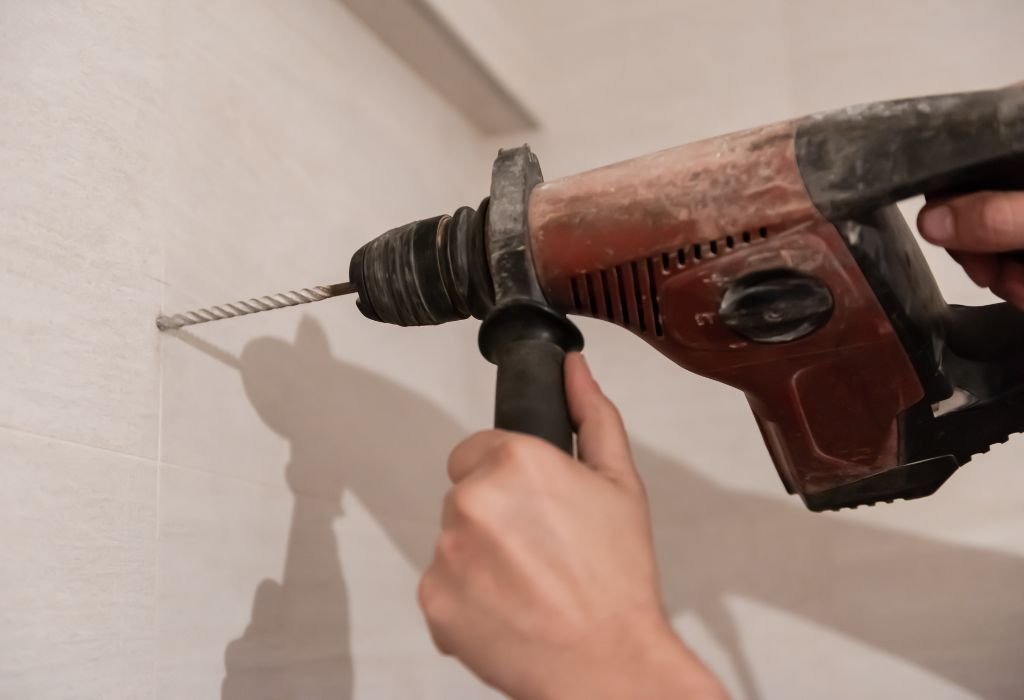Picture a contractor trying to drill into reinforced concrete with a regular drill. The bit spins, heats up, and eventually burns out while the surface barely dents.
This struggle is common on construction sites and home projects.
It raises the crucial question: what is a rotary hammer and why is it different from other drills?
A rotary hammer is engineered for jobs that regular drills cannot handle. Its piston-driven mechanism delivers far more power, making concrete and masonry drilling faster and safer.
Studies show rotary hammers can cut hole times by up to 50% compared to hammer drills, reducing fatigue for workers who face long shifts (Bosch Tools).
The global power tools market, projected to surpass $40 billion by 2030, reflects growing demand for these versatile machines (Allied Market Research).
Quick Answer — What Is a Rotary Hammer?

A rotary hammer is a heavy-duty power tool that drills and chisels hard materials like concrete, brick, and stone. It combines rotary motion with a piston-driven hammering force that outperforms standard drills.
Unlike hammer drills that depend on gear-based impact, rotary hammers use compressed air pistons to create powerful strikes. This makes them ideal for tough environments like construction, demolition, and remodeling.
Most rotary hammers include SDS chucks, a system that locks bits securely. This design prevents slippage and ensures high torque transfer during drilling.
They come in corded and cordless models with different SDS sizes (SDS-Plus for light work, SDS-Max for heavy tasks). Each version serves beginners and professionals differently.
Is a rotary hammer the same as a hammer drill?
No. Rotary hammers use piston impact, while hammer drills use mechanical clutches.
What can a rotary hammer drill into?
Concrete, stone, brick, masonry, and reinforced concrete.
Is it beginner-friendly?
Yes. Ergonomic designs and safety modes make them accessible to DIY users.
Do they only drill holes?
No. They also perform chiseling, tile removal, and demolition.
Why choose one over a regular drill?
It offers faster drilling, deeper penetration, and less fatigue.
Anatomy & How It Works
Core Components
Every rotary hammer contains several critical parts. The motor powers a piston, while the SDS chuck system locks in specialized bits.
Mode selectors let users switch between drilling, hammering, or a combination of both. Auxiliary handles provide stability during extended use.
Most models feature anti-vibration technology to protect the operator. Cooling vents, dust seals, and durable housings ensure long-term performance.
SDS chucks are standard, with SDS-Plus for medium jobs and SDS-Max for heavy-duty drilling and demolition. These fittings make bit changes quick and secure.
What does SDS stand for?
Slotted Drive System, designed for secure bit retention.
Why is SDS better than standard chucks?
It prevents slipping and handles heavy torque.
Are SDS-Plus and SDS-Max interchangeable?
No. Each requires matching tools and bits.
Do all rotary hammers use SDS?
Most modern ones do, especially professional models.
Does handle design affect performance?
Yes. Ergonomic grips reduce vibration and strain.
Mechanism of Action
The true power of a rotary hammer lies in its hammering mechanism. Unlike gear-based hammer drills, it uses a piston to generate compressed air.
This air pushes a hammer into the bit, delivering strong, repetitive blows. Each strike is independent of the user’s pressure, ensuring consistent power.
The piston-driven design allows deep drilling without excessive force. As a result, operators can work longer without experiencing heavy fatigue.
This system also protects the tool from overheating and reduces wear. It delivers efficient energy transfer from motor to bit.
How does it differ from hammer drills?
Rotary hammers use pistons, hammer drills use clutches.
Why is it more effective?
Because impact force is generated mechanically, not manually.
Does it reduce fatigue?
Yes. Less user effort is needed for tough materials.
Can it break reinforced concrete?
Yes, with proper carbide bits.
Is the mechanism durable?
Yes, but maintenance is key to longevity.
Types of Rotary Hammers
Corded Rotary Hammers
Corded models are powerful tools designed for continuous use. They deliver constant torque and do not rely on batteries.
These hammers are often heavier and suited for jobsite conditions. Their strength makes them ideal for concrete drilling and demolition.
Corded tools are preferred for long workdays and demanding jobs. They offer reliable performance without power interruptions.
However, cords limit mobility and may require extension cables. They also depend on access to electrical outlets.
Who should use corded rotary hammers?
Professionals handling heavy-duty tasks.
Are they stronger than cordless models?
Yes, they deliver consistent high torque.
Do they overheat?
Not if cooled and maintained properly.
What’s their main drawback?
Limited portability due to cords.
Are they durable?
Yes, designed for extended jobsite use.
Cordless Rotary Hammers
Cordless rotary hammers use lithium-ion batteries. They allow greater mobility and convenience.
Modern brushless motors make cordless models nearly as powerful as corded versions. They are lighter, quieter, and easier to transport.
Batteries typically last 1–2 hours of continuous work. Spare packs extend runtime on large projects.
They are ideal for field jobs, home renovations, and mobile work environments.
Who benefits most from cordless models?
DIYers and mobile contractors.
Are they as strong as corded?
High-end models come close.
Do they cost more?
Yes, battery systems add expense.
Is runtime limited?
Yes, but extra batteries solve the issue.
Are they beginner-friendly?
Yes, they are lighter and easier to handle.
SDS-Plus vs SDS-Max
SDS-Plus tools handle general construction and light masonry. They are smaller and beginner-friendly.
SDS-Max hammers are larger and stronger. They drill wider, deeper holes and handle chiseling tasks.
Choosing between them depends on workload. Light projects require SDS-Plus, while professionals need SDS-Max.
Both use the same secure SDS system but differ in size and power.
What’s SDS-Plus used for?
Light to medium drilling tasks.
What’s SDS-Max used for?
Heavy-duty drilling and demolition.
Can they use the same bits?
No, they require different shank sizes.
Which is easier for beginners?
SDS-Plus, due to its lighter weight.
Which do professionals prefer?
SDS-Max for power and durability.
Rotary Hammer vs Hammer Drill vs Impact Drill

Rotary Hammer vs Hammer Drill
Rotary hammers and hammer drills may look similar. However, their internal mechanisms are completely different.
Hammer drills use gears and clutches to simulate hammering. Rotary hammers use pistons for stronger impact energy.
This makes rotary hammers far better for concrete and stone. Hammer drills are better suited for brick and light masonry.
For general drilling tasks, hammer drills are lighter and more affordable.
Which is more powerful?
Rotary hammers deliver greater impact force.
Which is cheaper?
Hammer drills are usually less expensive.
Which lasts longer in masonry?
Rotary hammers are built for heavy-duty use.
Which tool is lighter?
Hammer drills are smaller and easier to carry.
Can they both drill concrete?
Yes, but rotary hammers are much faster.
Rotary Hammer vs Impact Drill
Impact drills are designed for driving screws and bolts. They use torque, not hammering force.
They are not intended for concrete drilling. Attempting to use them on masonry risks damaging the tool.
Rotary hammers, by contrast, excel at drilling and chiseling. They are purpose-built for hard surfaces.
Both tools are essential, but they serve different roles.
Is an impact drill the same as a rotary hammer?
No, they are designed for different jobs.
Can an impact drill handle concrete?
No, it lacks piston-driven force.
What is the impact drill’s strength?
Driving screws and tightening bolts.
Which is more portable?
Impact drills are lighter.
Do professionals use both?
Yes, depending on the task.
Common Uses of Rotary Hammers
Rotary hammers are designed for tasks that overwhelm ordinary drills. Their power makes them a go-to tool in construction and demolition.
They excel at drilling holes in concrete for anchors and rebar installation. With chiseling attachments, they can also remove tiles and break masonry.
Contractors often rely on them for heavy renovations. DIY homeowners use them for basement remodeling or breaking up slabs.
The combination of speed and durability saves both time and effort. This makes them an investment for professionals and serious hobbyists alike.
What jobs require a rotary hammer?
Concrete drilling, chiseling, demolition, and tile removal.
Can it drill through rebar?
Yes, with carbide-tipped SDS bits.
Is it suitable for wood or metal?
It can, but it is overpowered for soft materials.
Do homeowners need one?
Yes, if working on masonry or concrete projects.
Do professionals use them daily?
Yes, they are essential on many jobsites.
Benefits of Using a Rotary Hammer
The greatest advantage of a rotary hammer is efficiency. It drills faster and cleaner than standard drills.
Piston-driven impact reduces strain on the user. This makes it possible to work longer without fatigue.
Fewer broken bits and less tool wear save money. Over time, rotary hammers pay for themselves in productivity gains.
Their versatility also adds value. From drilling to chiseling, they cover multiple roles in one tool.
Is it faster than a hammer drill?
Yes, up to 50% faster in concrete applications.
Does it reduce strain?
Yes, by using piston force instead of user pressure.
Does it extend tool and bit life?
Yes, less stress means longer durability.
Is it versatile?
Yes, it can drill, chisel, and demolish.
Does it save costs long-term?
Yes, efficiency offsets initial investment.
Safety Precautions While Using Rotary Hammers
Rotary hammers are powerful tools that must be used with caution. Improper handling can cause injuries or equipment damage.
Personal protective equipment (PPE) is mandatory. This includes gloves, goggles, hearing protection, and respirators.
Dust and vibration are major risks. Using extraction systems and anti-vibration handles reduces exposure.
Confined spaces and overhead drilling demand extra care. Proper stance and controlled movements ensure stability.
What PPE is required?
Eye protection, gloves, respirators, and hearing protection.
Can prolonged use cause vibration injuries?
Yes, hand-arm vibration syndrome (HAVS) is a risk.
How can dust exposure be reduced?
By using dust extraction attachments or respirators.
Can bits break under pressure?
Yes, only SDS-rated bits should be used.
Are safety permits needed in workplaces?
Yes, in industrial and construction settings.
Choosing the Right Rotary Hammer
Selecting the right rotary hammer depends on job needs. Power rating, weight, and SDS system are critical factors.
Beginners should consider SDS-Plus models. Professionals drilling large holes need SDS-Max versions.
Corded models provide consistent torque for heavy use. Cordless models add convenience for mobile work.
Brand reputation and warranty also matter. Top names include Bosch, DeWalt, Makita, and Hilti.
What power rating is best for beginners?
2–4 joules of impact energy.
What do professionals prefer?
6+ joules for reinforced concrete.
Does weight affect performance?
Yes, lighter for overhead, heavier for demolition.
Are cordless models reliable?
Yes, modern brushless motors make them strong.
Are premium brands worth it?
Yes, they last longer and offer better support.
Maintenance Tips for Rotary Hammers

Regular maintenance extends tool life and performance. Neglecting upkeep can shorten lifespan significantly.
SDS chucks require periodic lubrication. This reduces wear and keeps bits secure.
Dust buildup should be cleaned after every use. Vents and filters prevent overheating and motor failure.
Carbon brushes wear out over time. Replacing them restores full motor efficiency.
Do rotary hammers need oiling?
Yes, SDS mechanisms need lubrication.
Do brushes wear out?
Yes, they must be replaced periodically.
Does dust harm the motor?
Yes, clogging causes overheating.
Is storage important?
Yes, keep tools dry and dust-free.
Should bits be maintained too?
Yes, dull bits should be sharpened or replaced.
Future Trends in Rotary Hammers
Rotary hammer technology continues to evolve. Advances focus on power, portability, and safety.
Cordless models are becoming more dominant. Battery improvements now allow near-corded performance.
Brushless motors extend lifespan and efficiency. They also reduce heat and vibration during use.
Smart tools with sensors and connectivity are emerging. These features improve safety monitoring and tool tracking.
Are brushless motors the future?
Yes, they increase durability and efficiency.
Will cordless replace corded?
Eventually, as batteries improve further.
Is vibration control advancing?
Yes, better handles reduce fatigue risks.
Are smart rotary hammers available?
Yes, some brands include digital sensors.
Will SDS systems change?
Likely refinements, but SDS remains standard.
Conclusion
So, what is a rotary hammer? It is a power tool that combines rotation and piston-driven impact to handle jobs standard drills cannot.
From concrete drilling to chiseling tiles, it delivers unmatched performance. Professionals and serious DIYers rely on it for speed and efficiency.
With proper safety practices, a rotary hammer reduces fatigue and extends tool life. Regular maintenance ensures years of reliable service.
Final advice: Choose the right model, wear protective gear, and respect its power. A rotary hammer will outlast and outperform ordinary drills every time.

I’m John F. Nicholas, the founder, lead writer, and drill enthusiast behind 101drill.com. With years of hands-on experience in power tools and DIY projects, I created this platform to share practical knowledge, expert tips, and real-world insights to help others master the art of drilling.
